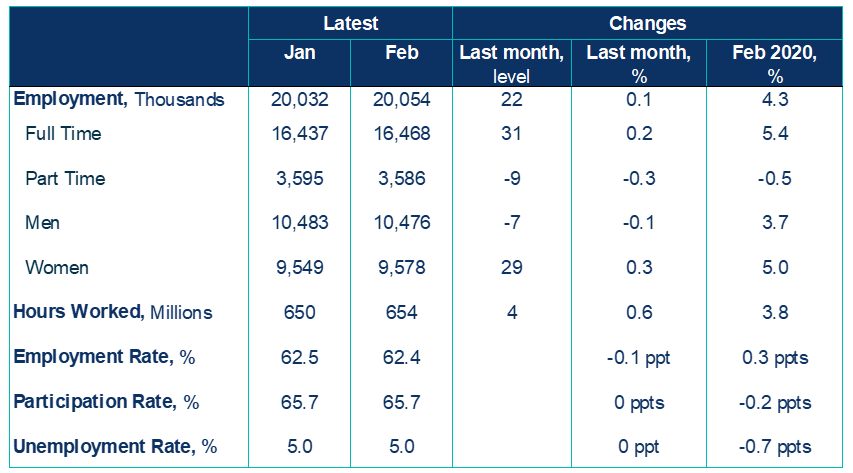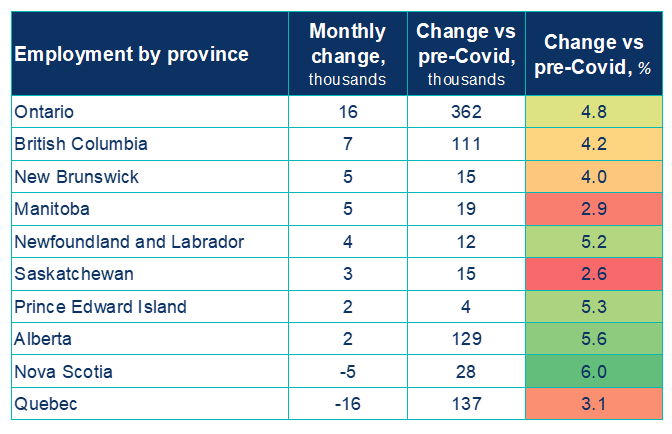Commentaries /
March 2023 LFS: Canada’s job market continues to outperform expectations in February
March 2023 LFS: Canada’s job market continues to outperform expectations in February
Amid high interest rates and slowing economic growth, February’s jobs report shows there's still plenty of steam left in the engine for Canada’s labour market.



Marwa Abdou


Amid high interest rates and slowing economic growth, February’s Labour Force Survey results shows there’s still plenty of steam left in the engine for Canada’s labour market. Following on last month’s blockbuster showing, this is another strong report – once again exceeding market expectations. We added another 22,000 jobs, and the unemployment rate held steady at 5.0%, close to its all-time low.
As we continue to monitor the economy for signs of cooling, hours worked keep rising, which suggests Canadian real GDP will get back into positive territory in 2023 Q1. Perhaps the biggest surprise is that average hourly wages rose 5.4% on year over year in February, up noticeably from 4.5% the month earlier. This number may cause the BoC to re-think its strategy of hold off on further rate hikes.
One thing is clear, the labour market remains exceptionally tight, keeping the keys firmly in the hands of job-seekers. It may be a while longer before the acute labour pressures that have plagued businesses begin to lift.
– Marwa Abdou, Senior Research Director, Canadian Chamber of Commerce
KEY TAKEAWAYS
- At 5.0%, Canada’s unemployment rate remains stubbornly tight and refuses to budge from near-record lows of 4.9% posted last summer. Though it was anticipated to edge up slightly (+10k), February’s figures posted an additional gain of +22K jobs.
- Continuing to be a strong driver of job growth were the employment numbers of workers aged 55 to 64 — +25K jobs (+0.7%) in February. This is the seventh month continuing a strong upward trend for this age group. Employment among youth and core-aged adults saw little change.
- Most of February’s job gains came from upticks in the fields of health care and social assistance (+15K; +0.6%), public administration (+10K; +0.9%), and utilities (+7.5K; +5.0%). The private sector also saw an impressive boost of 39K jobs (+0.3%), while public sector employment and self-employment saw little change. Conversely, jobs were lost in business services (-11K; -1.5%).
- Total hours also edged up an impressive 0.6% in February and are up 1.4% on a year-over-year basis.
- Average hourly wages rose 5.4% year-over-year — an uptick from January’s 4.5% after two months of deceleration. While this suggests households will have some spending power to navigate the rising living costs, the real risk is how this rebound will weigh on inflation—especially when labour productivity has been weak.
- Provincial employment increased in four provinces. After three consecutive months of lackluster growth, Manitoba posted a solid gain (+4.3K; 0.7%). Three of four Atlantic provinces saw modest rebounds after higher-than-average unemployment rates – New Brunswick (+5.1K; 1.3%), Newfoundland and Labrador (3.6K; 1.6%), Prince Edward Island (+1.7K; 2%). While there was little change in remaining provinces, Nova Scotia saw a decline (-4.7K; -0.9%).
- With its modest growth, February’s jobs report certainly brought more welcome news for job seekers. For the remainder of the economy, it leaves more room for doubt as to how much longer the market will continue to weigh on businesses as they continue to grapple with sustained recruitment and retention challenges amidst an extraordinarily difficult economic climate.
- As the gap between wage growth and inflation narrowed more this month, it remains to be seen whether this will be tip the Bank of Canada to lift its current hold on additional hikes as announced earlier this week.
SUMMARY TABLES





Other Commentaries

Oct 19, 2022
September 2022 Consumer Price Index data: Food and services prices still rising, no progress on core inflation

Sep 20, 2022
August 2022 Consumer Price Index data: Finally some good news on Canadian inflation.

Aug 16, 2022